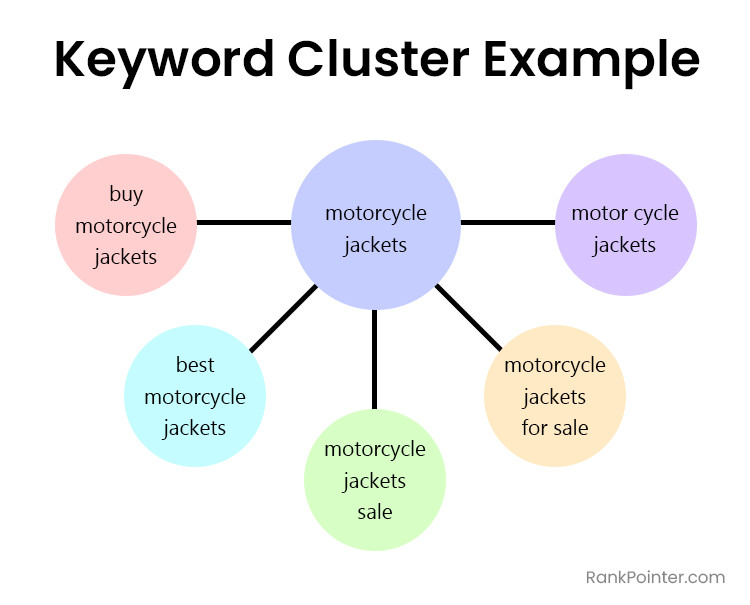By grouping keywords with similar intent, businesses can streamline their content creation efforts, improve user experience, and ultimately boost their rankings on SERPs. This comprehensive guide delves into the significance of keyword clustering, outlines a systematic approach to implementing it, and offers insights into optimizing content for maximum impact.
What Is Keyword Clustering?
Keyword clustering involves the process of categorizing keywords that share common themes or user intents.
Rather than targeting individual keywords with separate pages, clustering allows businesses to consolidate their efforts by addressing multiple related keywords within a single piece of content.
For example, terms like “motorcycle jackets,” “buy motorcycle jackets,” and “best motorcycle jackets” all revolve around the same core product, indicating a unified cluster of keywords with comparable search intent.

How to Do Keyword Clustering?
Step 1: Build a List of Keyword Ideas
Begin by compiling a list of relevant keywords pertinent to your industry or niche. Utilize keyword research tools to generate a comprehensive set of seed terms that encapsulate the primary focus areas of your business.
For example, if you operate in the realm of motorcycle apparel, your keyword list may include terms such as “motorcycle jackets,” “motorcycle gear,” and “riding accessories.”
Useful Article: Keyword Research: An In-Depth Guide for Beginners
Step 2: Categorize Your Keywords
Before diving into keyword clustering, it’s crucial to ensure that grouped keywords share a common search intent. Identifying search intent isn’t always straightforward, but it’s key to effective clustering:
Informational Intent
These keywords indicate users are seeking information or knowledge. For instance, “motorcycle jacket materials” suggests users want to understand the fabric or construction of jackets, reflecting informational intent.
Navigational Intent
Keywords with navigational intent suggest users are looking for a specific webpage or brand. For example, “Harley Davidson motorcycle jackets” indicates users are interested in jackets offered by Harley Davidson, showcasing navigational intent.
Commercial Intent
Keywords with commercial intent imply users are researching before making a purchase. Terms like “best motorcycle jackets” indicate users are seeking recommendations or reviews before buying, reflecting commercial intent.
Transactional Intent
These keywords suggest users are ready to take action, such as making a purchase. For instance, “buy motorcycle jacket online” indicates users are actively looking to purchase, showcasing transactional intent.
By analyzing SERPs and understanding the type of search intent each keyword reflects, businesses can categorize keywords into clusters effectively.
It’s essential to discern subtle differences between similar keywords, like “motorcycle jacket materials” (informational intent) and “best motorcycle jackets” (commercial intent), to create cohesive clusters aligned with user needs and intent.
Related Article: 8 Essential Types of Keywords for SEO
Step 3: Plan Your Keyword Strategy
With your keywords categorized into clusters, devise a strategic plan to target these clusters effectively. Determine which clusters are most aligned with your business objectives and audience preferences, and prioritize them accordingly.
Develop a content strategy that addresses each cluster comprehensively, ensuring that your content resonates with the intended audience and aligns with their search intent.
Step 4: Optimize or Create Content
Are you ready to craft or enhance content around your chosen keyword clusters? Here’s a rundown of crucial on-page SEO tactics to maximize your content’s visibility and relevance:
- Ensure the primary keyword appears in the URL slug, title tag, meta description, and H1 tag.
- Place the primary keyword within the opening paragraph of body content.
- Naturally incorporate both primary and secondary keywords throughout the body content.
- If unable to include secondary keywords in full, utilize unique words from them.
- Include secondary keywords within subheadings, where applicable.
- Add internal links to related pages, enhancing website navigation and SEO performance.
Step 5: Track Your Keyword Rankings
Continuously monitor the performance of your keyword clusters by tracking their rankings on SERPs. Utilize SEO analytics tools to assess the effectiveness of your keyword clustering strategy and identify areas for improvement.
If certain clusters fail to achieve desired rankings or traction, refine your approach iteratively based on performance data and user feedback.
Wrapping Up: Keyword Clustering
By creating keyword clusters, businesses can optimize their content strategy, enhance user experience, and ultimately elevate their rankings on SERPs. Embracing keyword clustering as a fundamental aspect of SEO optimization empowers businesses to execute digital marketing campaigns with precision and effectiveness.


